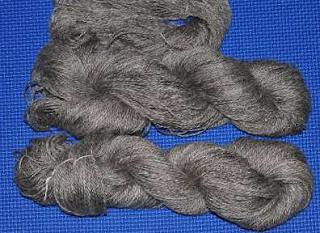 It's been interesting weaving. There were a couple of broken threads, not because of my spinning technique, but because the kitten kept a paws on interest in the project.
It's been interesting weaving. There were a couple of broken threads, not because of my spinning technique, but because the kitten kept a paws on interest in the project. 
 I wasn't sure the project was going to survive the kitten's activities. He was on the front of that loom, investigating more times that I could say. He was on the back beam as well, using it as a balance beam and finding the new repair warps enticing new toys.
I wasn't sure the project was going to survive the kitten's activities. He was on the front of that loom, investigating more times that I could say. He was on the back beam as well, using it as a balance beam and finding the new repair warps enticing new toys.I will admit that after several gentle admonishments and moving him off the loom, I got the squirt bottle. Yep, camera in one hand, because nobody would believe me if I just told them this happend and squirt bottle in the other. What has kitten learned? He's learned that when he sees the squirt bottle, he should move away, but he's not manage to equate the squirt bottle with any particular action. Thus we have a chewed rug, broken warp threads, chewed weft skeins and the list goes on. I hope this teething/growing/whatever stage, doesn't last much longer.
 However, I got the weaving done and the project off the loom. It only took me an hour to twist the fringes.
However, I got the weaving done and the project off the loom. It only took me an hour to twist the fringes. When my sweetie saw it, his comment was "Good choice on the colour", so I'm guessing the dye job worked out with acceptable results. I really like the varigation of the warp colours, which was happenstance from the natural colours of the fleece. I tried to keep bunches of similar shades together to have enough yardage to have sections of colour. I was able to do that because I flick carded all the fibre for the warp. If I'd carded them with the drum carder or hand cards, I could have had a homogenous colour, but where is the interest in that?
 What I like best is that this is no sleezy, wide sett fabric in order to make it soft and drapey. Nope, this is a decently stable sett, which will make a long lasting fabric and it's still soft and drapes really well. I love it when it all comes together.
What I like best is that this is no sleezy, wide sett fabric in order to make it soft and drapey. Nope, this is a decently stable sett, which will make a long lasting fabric and it's still soft and drapes really well. I love it when it all comes together.


















